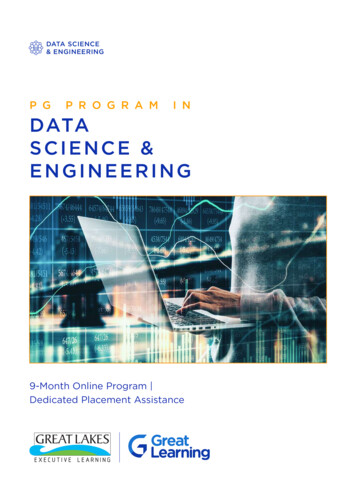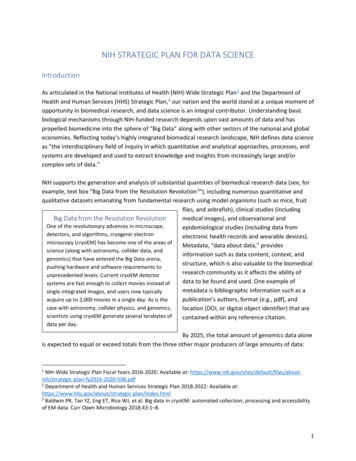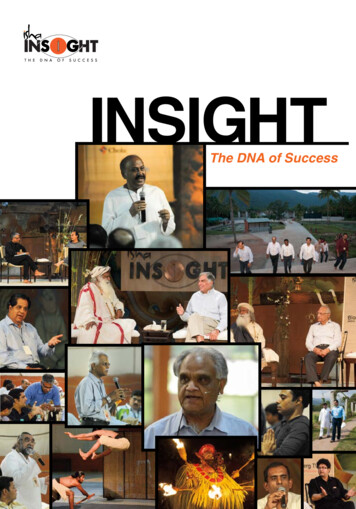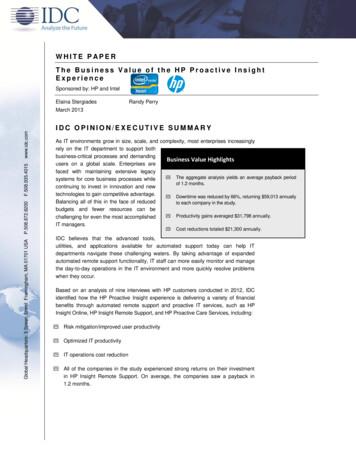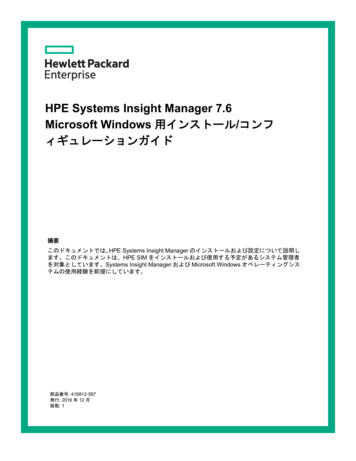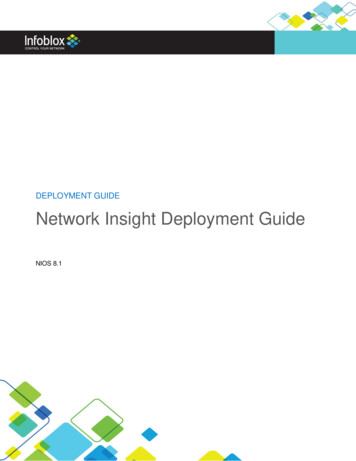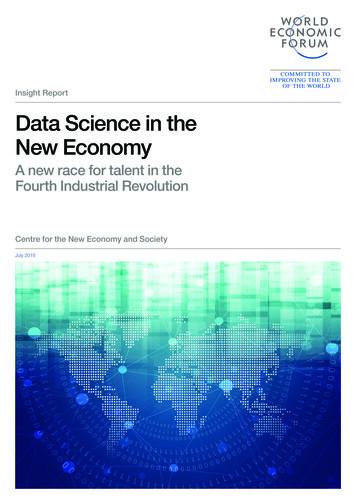
Transcription
Insight ReportData Science in theNew EconomyA new race for talent in theFourth Industrial RevolutionCentre for the New Economy and SocietyJuly 2019
This Report is produced by the World EconomicForum’s Centre for the New Economy andSociety as part of its New Metrics CoLabproject. For more information, or to getinvolved, please contact cnes@weforum.org.This Report has been published by theWorld Economic Forum as a contributionto a project, insight area or interaction. Thefindings, interpretations and conclusionsexpressed herein are a result of a collaborativeprocess facilitated and endorsed by theWorld Economic Forum, but whose resultsdo not necessarily represent the views of theWorld Economic Forum, nor the entirety of itsMembers, Partners or other stakeholders.World Economic Forum91-93 route de la CapiteCH-1223 Cologny/GenevaSwitzerlandTel.: 41 (0)22 869 1212Fax: 41 (0)22 786 2744Email: contact@weforum.orgwww.weforum.orgWorld Economic Forum 2019 – All rights reserved.No part of this publication may be reproduced ortransmitted in any form or by any means, includingphotocopying and recording, or by any information storageand retrieval system.REF 020719
Contents04 Key FindingsKey insightsImplications for decision-makers06 Emerging Demand for Data Science SkillsAcross IndustriesActionable InsightSource Data and Model10Learning Achievements in Data Science SkillsAcross Industries and RegionsActionable InsightSource Data and Model14Changing Composition of Data Science SkillsWithin RolesActionable InsightSource Data and Model19A Look at Future Demand for Data Science Jobs21AcknowledgementsThis Report has been published by theWorld Economic Forum as a contributionto a project, insight area or interaction.The findings, interpretations andconclusions expressed herein are a resultof a collaborative process facilitated andendorsed by the World Economic Forum,but whose results do not necessarilyrepresent the views of the WorldEconomic Forum, nor the entirety of itsMembers, Partners or other stakeholders.
Key FindingsThrough three industrial revolutions, technology has ledto significant changes across economies, societies andbusinesses. Steam engines jump-started the transition ofsocieties from agriculture to industrial production. The use offossil fuels in engines and innovation in business models suchas the assembly line rapidly scaled production. More recently,the digital revolution brought computing power and informationtechnology. Each successive industrial revolution has involvedsignificant shifts in the way people live and work, in how value iscreated in the economy, and demand for the highest-value skills.As the Fourth Industrial Revolution unfolds, led by advancesin technologies such as data science and artificial intelligence,the labour market is again changing in a fundamentalfashion. In 2018 the Future of Jobs Survey and Reportrevealed that business leaders believe that by 2022, humanworkers and automated processes are set to share theworkload of current tasks equally, while a range of new rolesis expected to emerge simultaneously as digital innovationis absorbed across industries and regions. In particular,in many large advanced and emerging markets, growth isexpected in sectors that will experience the bulk of these newroles, such as information technology, renewable energy,education and the care economy, and in occupations suchas data science, healthcare work and human resources.While the new labour market is changing at a rapid pace,emerging data sources are shedding light on its compositionwith a new depth and dynamism that has not previouslyexisted. Online platforms and specialized insight firms arenow offering new and complementary ways to understandhow specific skills, tasks and occupations are changingacross industries and geographies. While many of theseremain limited to specific populations—and difficult tocompare and contrast—when coupled with traditional andqualitative sources of data, they can help businesses, policymakers and workers have greater analytic capacity aboutthe present and future of work and adopt better informedand coordinated business strategies and policies.The World Economic Forum’s Centre for the New Economyand Society is a platform for insights and action on emergingsocio-economic issues. As part of its agenda, the Centreoffers an opportunity for companies to partner with theForum to share insights on emerging trends in a diverse04Data Science in the New Economyset of issues such as education, skills, jobs, gender andinclusive growth. This Report is among a series of suchcollaborations aimed at developing new metrics and deployingdata for shedding light on public good challenges.It has become commonplace to refer to data as the ‘new oil’ ofthe global economy. Data scientists are the talent that providethe ability to extract, refine and deploy this new source of valuein the global economy. This Report focuses on data science,among the most competitive skills of the Fourth IndustrialRevolution, in collaboration with Burning Glass Technologies,LinkedIn and Coursera to shed light on how data science talentis being developed and deployed across today’s labour market.In the first wave of digitization, data could be seen as purely aby-product of the functioning of digital applications, operatingsystems and platforms. Data is now increasingly recognizedas a significant asset enabling further innovation acrossancillary fields such as artificial intelligence, which can drivethe improvement of services through process efficiency anddeliver better results for customers. The dividends of newsources of data and methods of processing are not limitedto the private sector; the public sector increasingly usesdata to improve government services and academia appliesnew methods to enhance research. Yet the rapid rise in thedemand for workers with skills in data science has led to ashortfall in data science skills supply and intense competitionbetween industry, academia and the public sector for suchtalent. This has created a high premium on such skills andhas reduced the capacity of businesses, industries and entireeconomies to leverage fully the dividends of innovation.What do we know about how recent demand for thistalent is emerging across industries, how data scienceskills are becoming part of the core composition ofroles and how workers are expanding their data scienceskillset through new learning across industries andregions? What do we know about how data sciencedemand might be expected to grow in the future?In this paper, we look at three complementary ways in whichleaders can understand the market for data science skillsacross the new economy: monitoring the demand for datascience skills through job posting analysis from Burning GlassTechnologies; the distribution and quality of data science
talent across industries and regions based on learner skillsinsights from Coursera; and analysing the rising prevalenceof data science skills within the core composition of selectedroles through user profile analysis from LinkedIn. Finally, weconclude with a look towards the future demand for datascience skills across industries, drawing from the insights ofexecutives of the largest companies in the world surveyedthrough the World Economic Forum’s Future of Jobs Survey.Key insights1. While data science roles and skills form a relativelysmall part of the workforce, recent trends indicatethat these are currently among the highest indemand roles in the labour market.2. The demand for data science skills is not limited to theInformation Technology sector as data’s importancegrows across multiple sectors, including Media andEntertainment, Financial Services and Professional Services.3. Data science skills are particularly critical to a distinctive setof growing roles. For example, in the United States thoseroles are Machine Learning Engineers and Data ScienceSpecialists. These skills are only nominally in demand acrossmore traditional roles such as Relationship Consultants,but those roles are also facing major churn in skills.4. The data science skillset is not fixed and is rapidlyevolving as new opportunities in data analysis andfurther technological advances redefine the specificskills composition of data scientist roles.5. The disparities in achievement of data sciencelearners point to varying levels of data sciencetalent across industries and economies:a. The Information Communication and Technology(ICT), Media and Entertainment, Financial Servicesand Professional Services industries are currentlytaking the lead both in hiring data science talentand in the achievements of online learners who areactively updating their skillsets across industries.b. Across most industries, online learners based in Europedemonstrate higher proficiency in data science skillsthan in North America, followed by emerging regions.Exceptions to such trends exist in sectors such asTelecommunications and Technology, where learners inthe Asia Pacific region and the Middle East and Africaoutperform regional averages across industries.6. Jobs such as Artificial Intelligence and MachineLearning Specialists or Data Scientists, in whichdata science skills are perhaps most profoundlyapplicable, are forecasted to be among the most indemand roles across most industries by 2022.Implications for decision-makersOverall, the rapid growth and evolution of data scienceroles and skills stresses the need for appropriate businessstrategies and education and training policies that can matchthis demand, in quantity and quality, so that skills shortagesdo not hinder the transformation potential unveiled by vastsources of data and improved data analysis techniques.Industries and countries that fail to understand and addressthese dynamics risk slower growth and dynamism.More precisely, the insights included in this Report pointto the following implications:——In the Fourth Industrial Revolution all sectors will needto undergo a fundamental transformation to fullyabsorb the potential dividends of the data economy.Such transformations will need to be accompanied byappropriate talent investments in data science skills.——Industries that have been able to capture a large shareof high-skilled talent in more traditional data scienceskills such as statistics or data management cannot becomplacent, and they need to make fresh investmentsin newer skills, such as data visualization or statisticalprogramming, if they wish to meet their innovation potential.——A one-shot investment in reskilling will not be sufficient.Given the rapid pace of change within data scienceprofessions, maintaining skillset relevance will requireresponsive and dynamic upskilling systems that respond tofast-changing technologies and associated skills demand.——Differences in achievements of online learners acrossindustries and regions showcase potential data scienceskills capacity gaps which, if left unaddressed, may reducethe innovation and competitiveness potential of specificbusinesses, industries and regions. Public and private sectorstakeholders in these regions will need to consider greaterinvestment in data science. Given the rising demand forsuch skills, this investment is likely to generate significantreturns for individuals and companies and contribute togenerating new pathways for socio-economic mobility.The sections that follow present three new metric scorecardsthat individually and collectively shed new light on data scienceroles and skills in the labour market of the Fourth IndustrialRevolution. The collection provides one starting point to whatcould be further efforts aimed at tracking skills demand andcapacity across emerging sectors such as renewable energyand the care economy. This exercise can set the foundationsto analyse skills dynamics in other sectors, building on thepotential of multi-source data collaboration to create coherentframes of analysis and common taxonomies that canprovide business and policy leaders with a common frameof reference. Finally, this Report presents a forecast on theimportance of data analysis jobs across multiple industries.A new race for talent in the Fourth Industrial Revolution05
Scorecard 1Emerging Demand forData Science SkillsAcross Industries06Data Science in the New Economy
Online Markets and Data skillsets, five-year trend, by industryDemand for Online Markets skills, percent*Demand for Data skills, percent*12Aviation, Travel & Tourism12Chemistry, Advanced Materials & BiotechnologyConsumer1010EducationEnergy8Financial Services & Investors8Global Health & HealthcareGovernment & Public Sector6Information & Communication Technologies6InfrastructureMedia & Entertainment4Mining & Metals4MobilityNon-Profit22Oil & GasProfessional �15’16’17’18Source: Burning Glass Technologies.Note: Demand is calculated as the number of times that skills in the Online Markets and Data skillsets are mentioned in job postings as a share of all skillsthat are mentioned.Online Markets and Data skillsets relative position and growth,by industryIndustry, percentage gain in demand for Online Markets skills*Media & Entertainment, 14 %20132018Industry, percentage gain in demand for Data skills*ICT, 59 %20132018Non-Profit, 1 %Media & Entertainment, 50 %Professional Services, 7 %ICT, 18 %Fin. Services & Investors, 88 %Education, 15 %Fin. Services & Investors, 44 %Professional Services, 69 %Energy, 67 %Chem., Adv. Mat’ls. & Biotech, 83 %Infrastructure, 42 %Consumer, 27 %Non-Profit, 83 %Chem., Adv. Mat’ls. & Biotech, 32 %Gov’t. and Public Sector, 56 %Consumer, 50 %Mobility, 26 %Gov’t. and Public Sector, 67 %Aviation, Travel & Tourism, –21 %Global Health & Healthcare, 0 %Education, 50 %Mining & Metals, –22 %Oil & Gas, –286 %Mobility, 0 %01248Demand for Online Markets skills, percent*0.00.71.4Demand for Data skills, percent2.1Source: Burning Glass Technologies.Note: Demand is calculated as the number of times that skills in the Online Markets and Data skillsets are mentioned in job postings as a share of all skillsthat are mentioned.A new race for talent in the Fourth Industrial Revolution07
Emerging Demand forData Science SkillsAcross IndustriesActionable InsightThe metricThe Burning Glass Skills Metric tracks demand for the skillsthat accompany the adoption of new technologies. When anew job is posted online, an algorithm distils relevant data,such as the type of role advertised and the skills required forthe role. The changing share of skills mentioned in job postingsviewed as a trend can be analysed in an aggregate fashion toindicate rising and falling demand for specialized talent. Suchchanges in business’ search for specialized human capital canalso serve as a proxy for business investment in technologies.This metric offers new insights into the demand forskills across industries. A job posting communicatesa required skill that is important, new or unusual. Theinformation that is scraped and distilled from such a sourcecorresponds to the skills that are either fundamentalor new requirements for roles in the labour market.In a labour market in transition, the skills requirements detailedin newly advertised roles offer an early indication of the adoptionof new technologies and associated changes in process.They showcase the intentions of business leaders to matchinvestment in new technologies with appropriate human capital.Key insightsThis scorecard examines changes in industry demand for acluster of skills related to user and entity big data analytics.That data is then contrasted against the demand for a set ofskills associated with app and web-enabled markets. Thesetwo skills clusters correspond to two of the technologies thatwere identified in the Future of Jobs Report 2018 as mostlikely to be adopted in the horizon up to 2022. The clusterof skills included in the App- and Web-enabled Marketsskillset—abbreviated to Online Markets throughout thisReport—includes skills such as: social media, paid search,e-commerce and mobile application design. The skills clusterincluded in the User and Entity Big Data Analytics skillset (orData skillset) includes skills such as: Apache Hadoop, Hives,Big Data, Oracle Big Data and AWS Elastic MapReduce.The comparison between both skillsets for the period between2013 and 2018 across different industries show some commonfeatures. Notably, the industries making more investments08Data Science in the New Economyare the Media and Entertainment (ME), Professional Services(PS), Information and Communications Technologies (ICT)and Financial Services (FS) industries. At the same time, thedata also reveals sharp differences. More precisely, it showsthat the demand for data skills is still relatively modest incomparison to online markets skills. However, the figures alsoshow that the demand for data skills is growing quickly. Moreprecisely, between 2013 and 2015 the demand for data skillsincreased by 59%, 50%, 69% and 88% for the Informationand Communications Technologies (ICT), the Media andEntertainment (MEI), Professional Services (PS), and FinancialServices (FS) industries, respectively. In contrast, demandfor skills related to online markets rose by 18%, 14%, 7%and 44% for the same industries during that same period.A closer examination of the trends for the Online Markets skillsetreveals some industries have experienced demand peaksduring particular years. Such peaks in demand can be observedin the Not-for-Profit industry in 2014 and the Government andPublic Sector industry in 2017. Those peaks can be interpretedas an acute demand for specialized human capital as newtechnologies are adopted, followed by relative slowdown indemand for related skills as those technologies start to mature.The Burning Glass Skills Metric offers an opportunity tounderstand the ebbs and flows of demand for specializedtalent across the labour market in near real time and ingranular detail. Such data allows decision-makers to trackskills demand and technology adoption across industriesand regions. The metric can be further expanded bycomplementing the understanding of the scale of demandfor specific skills in the labour market with an understandingof the incentives for workers to upskill in the form of wages.Implications for decision-makersThe value of this data lies in allowing individuals, businessesand policy-makers to understand the upsurge in demandfor new skills across industries with a view to moredynamically addressing skills shortages or mismatches.It also supports leaders in targeting future investment inspecialized human capital within and across industries.
Source Data and ModelThe dataset compiled by Burning Glass Technologies isbased on online job postings. This information is sourcedby ‘scraping’ detailed data for a role from various onlinesources such as job boards and employer sites. Posts arethen analysed, and key information is distilled from eachposting. That key information includes the skills listed withinthe advertisement and the role advertised. Categories suchas roles and skills are then further refined through methodssuch as clustering algorithms to arrive at data pointsorganized by a coherent occupation and skills taxonomy,such as the O*NET occupational classification. For the currentanalysis the Burning Glass Technologies skills taxonomy isfurther mapped to a list of new technologies defined in theWorld Economic Forum’s Future of Jobs Report 2018.The resulting measures of skills prevalence represent theshare of job postings that mention a specific set of skills duringany one year and can be interpreted as skills demand—as in this scorecard. Across industries, a skills cluster israrely mentioned in more than 10% of job postings. Of thecombinations of cluster and role combinations examined, about95% list a skills prevalence measure under 10%. It’s best tofocus interpretations of the listed figures on the distributionof values by industry and on the growth trend over time.A new race for talent in the Fourth Industrial Revolution09
Scorecard 2Learning Achievementsin Data Science SkillsAcross Industriesand Regions
Data science skills proficiency by industry, grouped by skills clusterData Management1. Technology2. Professional Services3. Healthcare4. Finance5. Media and entertainment6. Telecommunications7. Consumer8. Insurance9. Manufacturing10. AutomotiveData Visualization1. Technology2. Healthcare3. Telecommunications4. Professional Services5. Consumer6. Automotive7. Manufacturing8. Insurance9. Media and entertainment10. FinanceMachine Learning1. Technology2. Telecommunications3. Professional Services4. Manufacturing5. Consumer6. Finance7. Media and entertainment8. Insurance9. Automotive10. HealthcareMathematics1. Technology2. Professional Services3. Telecommunications4. Insurance5. Finance6. Manufacturing7. Healthcare8. Automotive9. Media and entertainment10. ConsumerStat. Programming1. Technology2. Professional Services3. Telecommunications4. Manufacturing5. Finance6. Media and entertainment7. Healthcare8. Consumer9. Insurance10. AutomotiveStatistics1. Telecommunications2. Finance3. Technology4. Automotive5. Manufacturing6. Media and entertainment7. Professional Services8. Insurance9. Healthcare10. ConsumerSource: Coursera.Data science skills proficiency, by industry and regionAutomotiveSkills ClustersConsumerFinanceHealthcareInsuranceData ManagementData VisualizationMachine LearningMathematicsStat. ProgrammingNorth AmericaNorth AmericaMiddle East and AfricaMiddle East and AfricaLatin AmericaLatin AmericaEuropeEuropeAsia PacificAsia ncy (0–1, where 1 is best in class)ManufacturingSkills ClustersMedia & EntertainmentProfessional ServicesTechnologyTelecommunicationsData ManagementData VisualizationMachine LearningMathematicsStat. ProgrammingNorth AmericaNorth AmericaNorth AmericaNorth AmericaNorth AmMiddle East and AfricaMiddle East and AfricaMiddle East and AfricaMiddle East and AfricaMiddle ELatin AmericaLatin AmericaLatin AmericaLatin AmericaLatin AmEuropeEuropeEuropeEuropeEuropeAsia PacificAsia PacificAsia PacificAsia PacificAsia 50.751.000.00.250.751.000.00.250.751.00Proficiency (0–1, where 1 is best in class)l Asia Pacific l Europe l Latin America l Middle East and Africa l North AmericaSource: Coursera.Note: Regional data points might be excluded in cases where the data is inconclusive.A new race for talent in the Fourth Industrial Revolution11
Learning Achievements inData Science Skills AcrossIndustries and RegionsActionable InsightThe metricThe Coursera Global Skills Index evaluates learners acrosseconomies and industries and presents an indicative measureof their talent capacity across a range of critical skills. Eachcountry, region or industry is evaluated relative to its peers andlabelled with one of four categories – “Cutting edge” (score0.76 to 1.00), “Competitive” (score 0.51 to 0.75), “Emerging”(score 0.26 to 0.50) and “Lagging” (score 0.00 to 0.25).The courses and associated assessments that learnerstake on Coursera’s online learning platform offersvaluable insights into skills capacity across industries andeconomies. The data provides an indicative measure ofskills proficiency for talent across industries and regions.This is particularly important in the midst of the Fourthindustrial Revolution, when regions and industries need tounderstand, develop and deploy specialized talent in orderto ensure long-term labour and economic competitiveness.Key insightsThis scorecard presents differences in the assessed abilityof online learners who specialize in data science skills. Theresults reflect the skills investment made by individuals,classified by industry and region, and reveal their degree ofreskilling and upskilling achieved through online learning.The figure above illustrates the comparative strengths andweaknesses of learners across industries and regions againstthe six skill clusters contained in the Data Science skillset:Mathematics, Statistics, Statistical Programming, MachineLearning, Data Management and Data Visualization. Atthe most granular level, these six clusters can be furtherdisaggregated into more specific skills such as: calculus withinMathematics; linear regression within Statistics; programminglanguages such as R within Statistical Programming; neuralnetworks within Machine learning; Hadoop within DataManagement; and charting within Data Visualization.Among these six clusters, three have introduced significantinnovation in recent years: Statistical Programming,Data Visualization and Machine learning.12Data Science in the New EconomyOverall, the Technology industry, which is at the forefront ofthe Fourth Industrial Revolution, shows the most competitivetalent base in Data Science skills, both at the aggregate leveland across skills clusters. Two industries follow: ProfessionalServices and the Telecommunications industries.Industries that have performed well in more traditional dataskills, such as statistics or data management, cannot becomplacent and need to make fresh investments in moreinnovative data skills, such as data visualization or statisticalprogramming, if they wish to fulfil their innovation potential.The Finance industry, for example, falls under this category.Historically, it has maintained strong talent bases in quantitativeskills and, especially statistics. Learner achievements indicatethat the industry continues to be competitive in these traditionalareas of expertise despite increasing competition for talent fromthe Technology industry. However, the achievements of Financeindustry learners showcase lower skills proficiency acrossother skills such as Statistical Programming and MachineLearning where the industry ranks 5th and 6th, respectively.The skills proficiency of learners varies by region. Forexample, in the Finance industry, learners across Europeare assessed as being at the cutting-edge of talent,while in Latin America they are considered emerging.On average, online learners based in Europe demonstratehigher proficiency in Data Science skills than in NorthAmerica, followed by emerging regions. For example, theTelecommunications and Technology sectors learnersexhibit comparatively strong skills proficiency in the AsiaPacific and Middle East and Africa regions. Similarly,learners in the Middle East and Africa in the Automotiveindustries demonstrate cutting-edge data science skills.When comparing skills achievements across industriesand regions, some results are highly polarized. Forexample, in the European Healthcare sector, learnersachieve cutting-edge results in Data Management skillswhile learners in North America lag behind. For DataVisualization learners in the Media and Entertainmentindustry, the same pattern follows. For mathematics skills,that pattern is reversed: learners in the Consumer industryin North America outperform Europeans learners.
Differences in learner assessments may reflect both supplyand demand-side factors, such as quality of educationsystems or workplace demand for skills. Over the long term,persistent gaps in data science skills capacity across regionsand industries may exacerbate innovation and competitivenessdivides and hinder the development of specific countries,regions and industries. As data becomes an increasinglyimportant asset and labour markets demand more data scienceskills, policy-makers and business leaders must consider betterdevelopment and deployment of competitive talent for the newlabour market. The metric presented here can be expandedto further examine the relationship between output measuressuch as stock market indices and productivity figures forindustries in the context of the varying achievements of learners.Implications for decision-makersThe granular analysis of skills proficiency for online learnersby industry and region can help identify opportunitiesto prioritize future talent specialization and targetcross-regional upskilling and reskilling opportunities.This can guarantee the long-term competitiveness ofregions and industries in the new global economy.Keeping pace with the fundamental market shiftsalready underway in the Fourth Industrial Revolutionwill demand coordinated investments in skilldevelopment—not just by individuals, but also bycompanies and governments around the world.Source Data and ModelThe Coursera Global Skills Index is built on a mappingof skills to the content of online courses teaching them,and the assessments used to asses performance withinthem. It leverages machine learning models trained on skilltags crowdsourced from the tens of millions of learnersand thousands of instructors on Coursera’s platform.Coursera builds a skill profile for each learner that is based onits performance across all attempted assessments, adjustingfor the difficulty of those assessments. A skill proficiencyvalue specific to an industry within a region is the averageof the skill profiles of learners in that industry and region,weighted by the level of certainty in the per-learner skillprofile. An industry-by-region proficiency ranking is eligible forinclusion if at least 100 learners from that industry and regionhave taken related assessments on the Coursera platform.Each proficiency value is ranked according to its skills indexscore, which is higher when learners in that group performbetter on assessments within any single skill cluster.To generate the industry-by-region proficiency rankingswithin each skills cluster, Coursera ranks each industry-byregion combination against the set with a sufficient numberof learners for that cluster. This produces a series of relativepercentile rankings. The percentile rankings are then organizedinto four categories: Lagging, Emerging, Competitive, andCutting-Edge. Each industry-by-region ranking falls into oneof these four categories based on relative per
Jul 01, 2019 · 4. The data science skillset is not fixed and is rapidly evolving as new opportunities in data analysis and further technological advances redefine the specific skills composition of data scientist roles. 5. The disparities in achievement of data science learners point to varying levels of data sc

